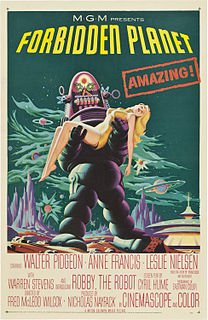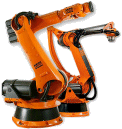
You Can't Do That on Television is a Canadian sketch comedy television series that first aired locally in 1979 before airing in the United States in 1981. It featured preteen and teenage actors in a sketch comedy format similar to that of American sketch comedies Rowan & Martin's Laugh-In and Saturday Night Live. Each episode had a specific theme normally relating to pop culture of the time. During its original run, the show was seen as one and the same with Nickelodeon, achieved high ratings, and is most famous for introducing the network's iconic green slime. The show was also notable for launching the careers of many performers, including alternative rock musician Alanis Morissette, filmmaker Patrick Mills, and screenwriter Bill Prady.

In medicine, a prosthesis or prosthetic implant is an artificial device that replaces a missing body part, which may be lost through trauma, disease, or a condition present at birth. Prostheses are intended to restore the normal functions of the missing body part. Amputee rehabilitation is primarily coordinated by a physiatrist as part of an inter-disciplinary team consisting of physiatrists, prosthetists, nurses, physical therapists, and occupational therapists. Prostheses can be created by hand or with Computer-Aided Design (CAD), a software interface that helps creators design and analyze the creation with computer-generated 2-D and 3-D graphics as well as analysis and optimization tools.

Robby the Robot is a fictional character and science fiction icon who first appeared in the 1956 film Forbidden Planet. He made a number of subsequent appearances in science fiction movies and television programs, usually without specific reference to the original film character.

Terrance Stanley "Terry" Fox was a Canadian athlete, humanitarian, and cancer research activist. In 1980, with one leg having been amputated due to cancer, he embarked on an east to west cross-Canada run to raise money and awareness for cancer research. Although the spread of his cancer eventually forced him to end his quest after 143 days and 5,373 kilometres (3,339 mi), and ultimately cost him his life, his efforts resulted in a lasting, worldwide legacy. The annual Terry Fox Run, first held in 1981, has grown to involve millions of participants in over 60 countries and is now the world's largest one-day fundraiser for cancer research; over C$750 million has been raised in his name, as of January 2018.

An industrial robot is a robot system used for manufacturing. Industrial robots are automated, programmable and capable of movement on three or more axis.
The Transformers is a line of mecha toys produced by the Japanese company Takara and American toy company Hasbro. Initially a line of transforming mecha toys rebranded from Takara's Diaclone and Microman toylines, it spawned the Transformers media franchise.

The Mobile Servicing System (MSS) is a robotic system on board the International Space Station (ISS). Launched to the ISS in 2001, it plays a key role in station assembly and maintenance; it moves equipment and supplies around the station, supports astronauts working in space, and services instruments and other payloads attached to the ISS and is used for external maintenance. Astronauts receive specialized training to enable them to perform these functions with the various systems of the MSS.

Whatever Happened to... Robot Jones? is an American animated television series created by Greg Miller for Cartoon Network. It follows a robot named Robot Jones who attends the fictional suburban Polyneux Middle School in a retrofuturistic 1980s world. Every episode deals with Robot Jones obtaining research on an aspect of human life, which include music, facial hair, gym class, etc. He is guided by his three friends, who go by the nicknames Socks, Mitch, and Cubey. Robot Jones is often smitten with his crush, Shannon Westerburg, a tall young girl with orthodontic headgear and a prosthesis. In school, Robot Jones interacts with his teachers, Mr. McMcMc, Mr. Workout, and Mrs. Raincoat; the principal, Mr. Madman; and janitor Clancy Q. Sleepyjeans. His arch-rivals, Lenny and Denny Yogman, try to sabotage Jones's research by making school more difficult for him.

The Fairmont Château Laurier is a 660,000-square-foot hotel with 429 guest rooms in downtown Ottawa, Ontario, Canada, located near the intersection of Rideau Street and Sussex Drive and designed in a French Gothic Revival Châteauesque style to complement the adjacent Parliament buildings. The hotel is above the Rideau Canal locks and overlooks the Ottawa River. The main dining room overlooks Major's Hill Park. The reception rooms include the Wedgewood-blue Adam Room; the Laurier Room defined by Roman columns; the Empire-style ballroom and the Drawing Room featuring cream and gold plaster ornament. The hotel was designated a national historic site in 1980.

A school bus is a type of bus owned, leased, contracted to, or operated by a school or school district. It is regularly used to transport students to and from school or school-related activities, but not including a charter bus or transit bus. Various configurations of school buses are used worldwide; the most iconic examples are the yellow school buses of the United States and Canada.

Small Wonder is an American comedy science fiction sitcom that aired in first-run syndication from September 7, 1985, to May 20, 1989. The show chronicles the family of a robotics engineer who secretly creates a robot modeled after a human girl, then tries to pass it off as their adopted daughter, Vicki.

The Shuttle Remote Manipulator System (SRMS), also known as Canadarm, is a series of robotic arms that were used on the Space Shuttle orbiters to deploy, maneuver and capture payloads. After the Space Shuttle Columbia disaster, the Canadarm was always paired with the Orbiter Boom Sensor System (OBSS), which was used to inspect the exterior of the Shuttle for damage to the thermal protection system.
The War Amps is a Canadian registered nonprofit organization, established in 1918 to meet the needs of war amputees. The charity provides financial and advisory services to those who have lost a limb or total eyesight in military service during war and to provide similar services to Canadians who have undergone amputations.

Leslie West is an American rock guitarist, vocalist, and songwriter. He is best known as a founding member of the hard rock band Mountain.
Daniel Joseph MacDonald, was a Canadian politician from Prince Edward Island. He served as Minister of Veterans Affairs from 1972 to 1979 and again in 1980 until his death.
HERO is a series of several educational robots sold by Heathkit during the 1980s. The Heath Company began the HERO 1 project in October 1979, with the first release in 1982. Models include the HERO 1, HERO Jr., and HERO 2000. Heathkit supports the HERO robot line until 1995. All three were produced as kits, or for more money, prebuilt by Heathkit. The 1980s models are considered collectors items, due to their rarity. For the most part, they cannot perform practical tasks, but are more geared toward entertainment and education above all.

Yo Gabba Gabba! is an American-Canadian live action/puppet educational, musical children's television series starring five costumed toys coming to life and their friend DJ Lance Rock. The series premiered on Nick Jr. August 20, 2007 and ended on November 12, 2015. There is a single topic in each episode, e.g. "Adventure", "Friends", and "Dance", through songs and short storylines in the half-hour program. Additionally, the show teaches children life and social skills, such as sharing and trying new foods. It also encourages viewers to move along with and dance with the characters in the program. The show is noted for its indie-culture guest stars and bands, and for drawing visual inspiration from 8-bit video games and H.R. Pufnstuf, among other television shows. Created by Christian Jacobs and Scott Schultz, the show's learning process has parents, older siblings, and younger kids watch the show together rather than letting it act as a babysitter. The television program has spawned a touring live stage show, various toys and branded clothing. Trademarks relating to Yo Gabba Gabba! and its characters are held by GabbaCaDabra, LLC in partnership with The Magic Store and Spiffy Pictures.

The Omnibot (オムニボット) is a toy robot originally manufactured by Tomy in the mid-1980s. The name then came to apply to the successful line of robots manufactured by the company. The initial Omnibot was announced with expectations of restoring popular interest in robots, at a time when it was becoming obvious that robots with advanced AI such as R2-D2 were still a long way away. A more advanced version of the Omnibot was called the Omnibot 2000 and did not have a plastic bubble over its head. With the success of the Omnibots, the Omnibot range quickly expanded. After the North American video game crash of 1983 and its debilitating effect on the entire nascent home electronics industry, the Omnibot faded away but it was revived in the early 2000s. The latest version of the Omnibot is the i-SOBOT.

Cowboy Who? was an original 45 episode children's television series in Canada, which aired in a half-hour Sunday morning timeslot between 1990 and 1994 on the MCTV system. The show was a collaboration between then radio producer Jeff Green and the children's theatre group Salt & Pepper Theatre Company. In 1987, the Salt & Pepper Theatre Company had written and performed an 8-part series of 30 minute children's radio programs for Ottawa album oriented rock station CHEZ-FM on which Green had acted as producer and engineer. In addition, the theatre group had been involved with CHRO-TV, supplying children's theatre workshops in schools throughout the Ottawa Valley. When the Salt & Pepper Theatre Company were offered a regular slot on the station to help fulfill its CRTC license commitments for original local children's programming, they approached Green to collaborate on a series. In 1990, the team produced a pilot for Cowboy Who?, which gained them a commitment for a season of 13 episodes, and primary shooting began in the fall of that year. Two and a half more seasons were eventually created. The show spent several years in rotation on the MCTV stations.

A domestic robot is a type of service robot, an autonomous robot that is primarily used for household chores, but may also be used for education, entertainment or therapy. Thus far, there are only a few limited models, though speculators, such as Bill Gates, have suggested that they could become more common in the future. While most domestic robots are simplistic, some are connected to WiFi home networks or smart environments and are autonomous to a high degree. There were an estimated 3,540,000 service robots in use in 2006, compared with an estimated 950,000 industrial robots.

















